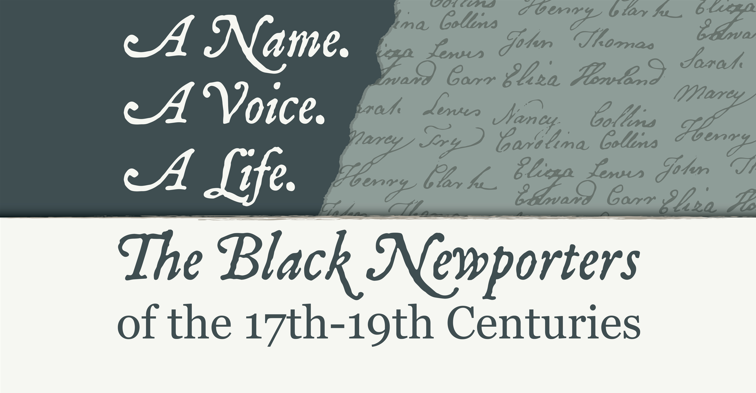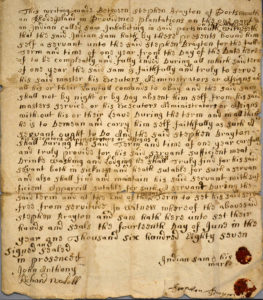
Location: Richard I. Burnham Resource Center, 82 Touro Street, Newport
Monday-Friday, 9am-3pm
Discover the rich narratives of five individuals of African descent who resided in Newport from its founding in 1639 to the abolition of slavery in Rhode Island’s constitution in 1842.
Delve into their connections, commercial endeavors, religious affiliations, and more through an immersive exhibit at the Newport Historical Society Richard I. Burnham Resource Center.
The exhibit also features interpretations by four local artists, offering visual insights into the lives and experiences of these historical figures.
This exhibit is made possible in part through grants from Rhode Island Humanities, an independent state affiliate of the National Endowment for the Humanities, and the Rhode Island State Council on the Arts, through an appropriation by the Rhode Island General Assembly and from the National Endowment for the Arts. This exhibit is also supported by the Decorative Arts Trust Dean F. Failey Grant Program, Newport Craft Brewing & Distilling Co., BankNewport, and Rhode Island Energy.

Hadi Falapishi, Going West, 2024. Oil paint, mixed media, cardboard, resin on wood panel. Courtesy of the artist and Andrew Kreps Gallery.
On the occasion of
The Great Elephant Migration
to kick off the year-long elephant migration across America,
beginning in Newport, RI at Rough Point, The Great Meeting House, The Breakers, and Salve Regina University
Great Friends Meeting House
21 Farewell Street, Newport, RI
5 July – 1 September 2024
(closed July 19, 20, 21)
Friday – Sunday, 12:00 pm – 4:00 pm
To learn more about this exhibit visit: https://www.artandnewport.org/

Interested in hosting this exhibit? Please submit a request through the form below.
Location: Brick Market, 127 Thames Street, Newport
Daily, 10am-4pm.
Since its inception in 1993, the multidimensional Museum of Newport History at the Brick Market has examined Newport County’s history through the use of images, objects, and texts. The items on display at the Museum make up less than five percent of the Newport Historical Society’s collection, which includes over 10,000 objects, 500 paintings, prints, and maps, and 200,000 photographs.
Exhibits feature James Franklin’s printing press, the figurehead from the yacht Aloha, photographs, furniture, colonial silver, paintings, objects of daily life and more, all from the collections of the Newport Historical Society. With the use of these items, the Museum interprets Newport from its colonized settlement in 1639 through the twentieth century.
Location: Brick Market, 127 Thames Street, Newport; Online at www.nahr-nhs.com

Indenture, Indian Sam
(June 14, 1687), FIC.2020.130, Collections of the Newport Historical Society
In 1638 the first European settlers on Aquidneck Island purchased settlement rights from Canonicus and Miantonomi, sachems of the Narragansett tribe. The agreement, signed by both the colonists and Native Americans, stated that the current inhabitants would remove from the island. The first Europeans to settle permanently were Anne Hutchinson and her followers, who had been banished from Massachusetts Bay Colony. They settled at present day Portsmouth. By the following year, disagreements within the group led to an offshoot settling at the southern tip of the island in present day Newport.
There is abundant evidence, however, that the Native people did not entirely abandon Aquidneck Island, but rather continued to make use of this land, while finding ways to adapt to the presence of European settlements. In addition, the Native people of South County were actively engaged in business and other activities that took them to Newport. This evidence is found in legal and court records; in merchant, tradesman, and doctor’s account books; in letters and reminiscences, and even in the artifacts of the Colonial period. This story has not been part of the dominant narrative of Newport’s development, which rather ignores the presence of Native peoples once the British colonists arrive. But it exists, as do the descendants of the people who left their mark in the record. Both deserve recognition.
Visit the exhibit in-person at the Brick Market, or online at www.nahr-nhs.com
Location: Brick Market, 127 Thames Street, Newport
For over three hundred years the Newport Tower, locally known as the Old Stone Mill, has stood atop the hill in what is now Touro Park. Over time, a myriad of theories about its intended use, dates of construction, and the identity of its builders have been discussed. Visit this exhibition to see the most prevalent theories about the tower’s history, and the evidence used to argue each position. We encourage you to think like an historian, analyze the information presented, and draw your own conclusion about the Newport Tower.

Location: Brick Market, 127 Thames Street, Newport
This exhibition explores Newport’s budding prominence in the transatlantic trade networks of the 18th century. Newporters participated in the trade system both as consumers of imported goods and creators of good for the export market. Showcased here are examples of luxury items purchased by residents from abroad and created by Newport craftsmen for sale both at home and overseas.